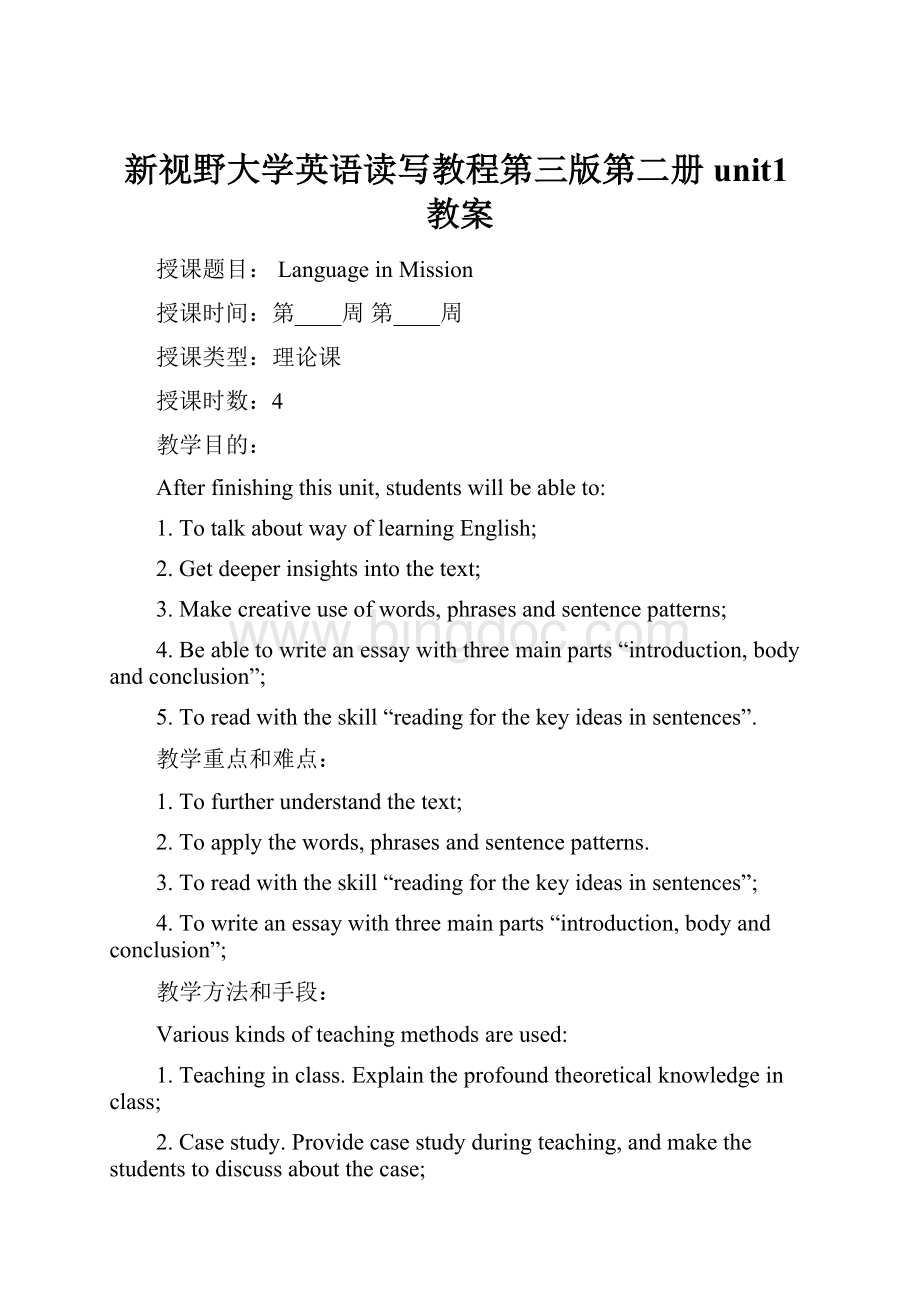新视野大学英语读写教程第三版第二册unit1教案.docx
《新视野大学英语读写教程第三版第二册unit1教案.docx》由会员分享,可在线阅读,更多相关《新视野大学英语读写教程第三版第二册unit1教案.docx(16页珍藏版)》请在冰点文库上搜索。

新视野大学英语读写教程第三版第二册unit1教案
授课题目:
LanguageinMission
授课时间:
第____周第____周
授课类型:
理论课
授课时数:
4
教学目的:
Afterfinishingthisunit,studentswillbeableto:
1.TotalkaboutwayoflearningEnglish;
2.Getdeeperinsightsintothetext;
3.Makecreativeuseofwords,phrasesandsentencepatterns;
4.Beabletowriteanessaywiththreemainparts“introduction,bodyandconclusion”;
5.Toreadwiththeskill“readingforthekeyideasinsentences”.
教学重点和难点:
1.Tofurtherunderstandthetext;
2.Toapplythewords,phrasesandsentencepatterns.
3.Toreadwiththeskill“readingforthekeyideasinsentences”;
4.Towriteanessaywiththreemainparts“introduction,bodyandconclusion”;
教学方法和手段:
Variouskindsofteachingmethodsareused:
1.Teachinginclass.Explaintheprofoundtheoreticalknowledgeinclass;
2.Casestudy.Providecasestudyduringteaching,andmakethestudentstodiscussaboutthecase;
3.BilingualandfullEnglishteaching;
4.Applyingmodernmultimediateachingtechnologies;
5.Takingadvantageofabundantnetworkteachingresources.
教学内容和过程:
SectionAAnImpressiveEnglishLesson
StepOneWarming-upActivities30minutes
I.Lead-in:
Discussthefollowingquestions:
1.WhatarethekeyfactorsthathelppeoplelearnEnglishasaforeignlanguage?
Goodcourse,excellentsyllabusbasedonsomeprinciples;
Highlydevelopedmethodologies,teachingfourprimaryskillsoflanguageacquisition;
Putthefourskillsintoadiscourse;
Analyzethreedifferentkindsofinteractions.
2.DoyouhaveanyprobleminEnglishlearning?
—Ialwaysfeelitdifficultto…
—It’snoteasyformeto…
understandwhatotherssay;
remembersomanywords;
learnthegrammar;
readquickly;
speakinpublic…
3.DoyouthinkgrammarisimportantinEnglishlearning?
—Yes.
Thebasicbuildingblocksofalanguage;
essentialforeffectivecommunication;
putthewordsintherightorder;
helptoconveycorrect,meaningfulmessage.
—No.
aslongasonecanunderstandwhatotherissaying;
dynamicandnolanguageisfixed;
speaktheirnativelanguagewithouthavingstudieditsgrammar.
II.Culturalbackground
Americanuniversityeducation
1.WhatisCommunicativeLanguageTeaching?
Atypeofteachingmethod;
Developthecommunicativeabilityaswellastheknowledgeofgrammar;Learningbydoing;
Makeclassroomsituationofrealforeignlanguageenvironment.
2.WhatarethefeaturesofCommunicativeLanguageTeaching?
Communicativecompetenceisthegoal;
Anintegrationofgrammaticalandfunctionalteaching;
Accuracyissecondarytoconveyingamessage;
Focusoncommunicativeandcontextualfactorsinlanguageuse;
Learner-centeredandexperience-based.
3.WhatistheroleofteacherinCommunicativeLanguageTeaching?
Afacilitatorofstudents’learning;
Amanagerofclassroomactivities;
Anadvisorofstudents’questions;
Aco-communicatorinthecommunicativeactivity.
StepTwoTextStudy80minutes
I.Interactivereadingofthetext
1.Readingcomprehension
1)Whatdoesthesonthinkofthefather?
(Para.1)
Atediousoddity:
afatherheisobligedtolistentoandamanabsorbedintherulesofgrammar.
2)Whywasthewritershockedbyhisstudent’sanswer?
(Paras.2-4)
3)SheisunabletodescribeherexcursiontoEuropewiththerightwords.
4)Whatconclusiondidthewriterdrawfromtheexampleofhisstudent?
(Para.5)
Studentsunfairlybearthebulkofthecriticismfortheseknowledgedeficitsbecausethereisasensethattheyshouldknowbetter.
5)Whyshouldstudentsnotbeblamedfortheirlanguagedeficiency?
(Paras.6-7)
6)Thelearningenvironmentismisleading.
7)Whyshouldstudentsnotbeblamedfortheirlanguagedeficiency?
(Paras.6-7)
8)Theyarenotlearningthelanguageadequatelyandefficientlyinschool.
9)Howshouldgrammarbetaughtasfarasthewriterisconcerned?
(Paras.8-10)
10)Grammarmustbehandleddelicately,stepbystep.Aneffectivewayofteachingcouldarousechildren’sinterestinlearningEnglishgrammar.
11)Anexample:
agrammarlessonwithmyson
12)
2.Structureofthetext
Introduction
Inhisson’seyes,thefatherisonewhohehastoobeyandanoddityabsorbedingrammar.(Para.1)
Hewasshockedbyhisstudent’sinabilityto
describeproperlyherexcursiontoEurope.(Paras.2-4)
Thesisofthenarration:
Itisunfairtoblamestudentsfortheirlanguagedeficiency.(Para.5)
Body
Explainswhystudentsshouldn’tbeblamedfortheirlanguagedeficiencybyprovidingtworeasonsandoneexample.(Paras.6-10)
ElaboratestheimportanceofgrammarandvocabularyinlearningEnglish.(Paras.11-13)
Concludingpart
Narratesanotherincidentwherehissonunconsciouslyutteredagrammaticallyperfectsentencewithasubjunctivemood,whichmadetheauthorsoproudofhisson.(Paras.14-17)
3.SummaryoftheText
Tomyson,Iama_____________:
afatherheis__________listentoandaman____________therulesofgrammar.AndIgot______________thisbecausemystudentwasunabletodescribeproperlyherfeelingonher__________toEurope.
However,itdoesn’t________________tocriticizeourstudents.Theyunfairlybearthebulkofthecriticismforthese__________________becausethereisasensethatthey_________________.Ononehand,theyaremisledbythe____________.Ontheotherhand,schoolfailsto_________________theessentialframeworkoflanguage,accurategrammarandpropervocabulary.
Perhaps,languageshouldbelookeduponasa_________anda___________________:
oftenstudytheroadmap(checkgrammar)and________thecarengine(adjustvocabulary).Learninggrammarandagoodvocabularyisjustlikedrivingwitharoadmapina________________car.__________,_________,and__________communicationdependsupongrammarandagoodvocabulary,thetwo__________assetsforstudents,buttheyare________________inschools.
II.LanguageFocus
Wordsandexpressions
1.oddity:
n.[C]astrangeorunusualpersonorthing怪人;怪物;奇特的东西
Withhisneatsuitson,hefeltlikeanodditywalkinginthispoorneighborhood.
穿着笔挺的西装走在这个贫民区里,他觉得自己就像个怪物。
2.oblige
Thewordobligeismostcommonlyusedintheexpressionbe/feelobliged.
1)be/feelobligedtodosth.指“感到有责任做某事”。
例如:
Hefeltobligedtohelphismother,evenifitmeantleavingcollege.他觉得有责任帮助母亲,即使这意味着他要离开大学。
2)be/feelobligedtosb./sth.指“对某人或某事心存感激”。
例如:
Thankyouverymuch,doctor.Iamextremelyobligedtoyou.医生,非常谢谢您。
对您,我深表感谢。
3.Howwasit?
:
(spoken)oftenusedinconversationtoasksb.abouttheiropinionorexperienceofsth.怎么样?
(口语常用表达,用于询问看法或经历)
Didyouwatchthemovielastnight?
Howwasit?
你昨天晚上看那部电影了吗?
感觉怎么样?
IwastoldthatyouhadtraveledtomanyplacesinAsiarecently.Howwasit?
有人告诉我你最近跑了亚洲的很多地方,旅行怎么样?
4.fullof:
(followedbyabstractnouns)feelingorshowingalotofparticularemotionorquality(感觉、表达或表现出)充满某种情感(特质)的
fullofexcitement/energy/hope/happiness/praise充满兴奋/活力/希望/幸福/赞美Theteacherwasfullofpraiseforthehomeworkthatthestudentshaddone.老师对学生们完成的功课赞不绝口。
Lucyisahappychildandalwaysfulloflife.露西是个快乐的孩子,总是充满了活力。
5.“Itwas,like,whoa!
”means“Itwasreallygreat!
”.“Itwaslike…”isaninformalexpressioninconversation,verycommonforyoungpeoplewhoarelazyandincapabletoreferencetheirideas.
Theexpressionisusuallyfollowedbyanadjectiveoranexclamation.Itwas,like,marvelous!
简直奇妙极了!
(Itwaslike)Whoa!
Howcomeyougotahundredpercentcorrectonsuchahardtest?
哇!
这么难的考试你怎么都全答对了?
Note:
Whoaisspecificallyusedtoshowthatpeoplearesurprisedorthinksomethingisveryimpressive.Itcanbeusedindifferentcontexts.
Forexample:
﹒
Todescribesomethingthatyou’renotquitesurehowtodescribe:
Thatcarissocool,it’slike,whoa.
Toexpresssurprise:
Whoa!
It’sreallyamazing!
Toindicateadesiretoendwhatsomeoneistalking:
Whoa,OK,that’senough.
6.Andthatwasit.(Para.4)
Meaning:
Andthatwaseverythingshesaid,withoutevenmentioninganydetailsofherwonderfulexperienceinEurope.
Thatwasit.:
oftenusedinconversationtosaythatsth.iscompletelyfinishedorthatasituationcannotbechanged就这样(指某事彻底结束或形势不能更改)
Thatwasit.Icouldnolongerhopeforapromotion,andmybossdidn’tevenwanttoseemeagain.就这样吧,我的升职再也没指望了,我的老板甚至不想再见到我。
That’sit.Thereisnothingmorewecando.就这样吧,我们也再没有别的办法。
7.distinguished,distinctive,distinct
这三个词词形相近,但意思有很大的差别,不能互换使用。
1)distinguished指“卓越的;杰出的;著名的”。
例如:
Hisgrandfatherhadbeenadistinguisheduniversityprofessor.他的祖父曾是一位杰出的大学教授。
2)distinctive指“(特征、性格或外表)独特的,有明显不同的”。
强调“表示差别的”、“有特色的”、“特殊的”。
例如:
Irenehadaverydistinctivevoice.艾琳有一个非常独特的声音。
Canyoufindthedistinctivewatermarksofthisstamp?
你能看到这枚邮票上明显的水印吗?
PupilsinHongKongusuallyhavedistinctivebadgesontheirschooluniforms.在香港,小学生的校服上常戴有颇具特色的徽章。
3)distinct表示“分明的;明了的;清楚的”。
例如:
Ihavethedistinctfeelingthatmyfrienddidnotrealizewhatwashappening.我明显感到我朋友并未察觉所发生的一切。
ThephotoyoutookinHongKongCulturalCentreisnotdistinctenough.你在香港文化中心拍的那张照片不够清晰。
Shehasadistinctpronunciation.她的发音清楚。
Thereisadistinctsmellofsmokeinmyroom.我的房间里有一股明显的香烟味。
distinct的另一个词义是“明显不同的;有区别的”。
例如:
Ourinterestswerequitedistinctfromthoseofthem.我们的兴趣与他们的兴趣截然不同。
现将distinct和distinctive用在一个句子里,以便区分:
Oneofthedistinctivefeaturesofthisbookisitsdistinctillustrations.这本书很明显的特点之一就是其具有清楚明了的图解。
8.proclaim,claim
1)proclaim是正式宣告或公开宣告,“宣告”的中文意思比“声明”要严肃。
例如:
Thegovernmenthasproclaimedanewlaw.政府已公布了一项新法令。
Theyproclaimedthathewasatraitor.他们宣称他是叛徒。
Theringingbellsproclaimedthebirthoftheprince.响亮的钟声宣布了王子的诞生。
2)claim是根据权利声明,根据权利要求索赔,根据权利认领。
(1)声称;断言;主张。
例如:
Theyclaimtohavediscoveredacureforthedisease.他们声称已经发现了治疗此病的方法。
Sh